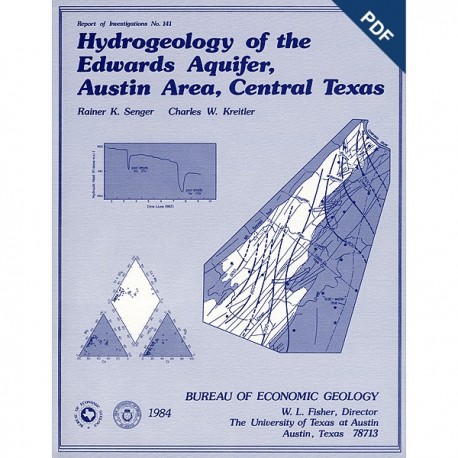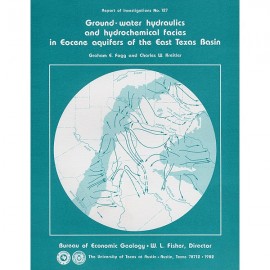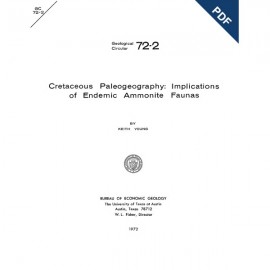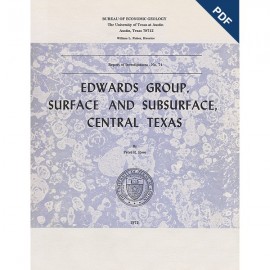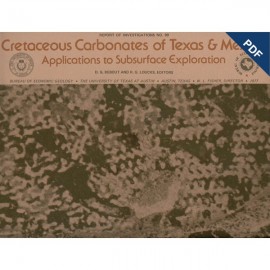Reports of Investigations
-
Books & Reports
- Reports of Investigations
- Guidebooks
- Udden Series
- Geological Circulars
- Down To Earth
- Atlases of Major Oil and Gas Reservoirs
- Texas Memorial Museum Publications
- Environmental Geologic Atlas of the Texas Coastal Zone
- Mineral Resource Circulars
- Other Reports
- Seminars and Workshops
- Handbooks
- Submerged Lands of Texas
- Symposia
- Annual Reports
- Open File Reports
-
Maps & Cross Sections
- Thematic Maps
- Miscellaneous Maps, Charts & Sections
- Geologic Atlas of Texas
- STATEMAP Project Maps
- Geologic Quadrangle Maps
- Cross Sections
- Highway Geology Map
- Energy and Mineral Resource Maps
- Shoreline Change and Other Posters
- Wilcox Group, East Texas, Geological / Hydrological Folios
- Bouguer Gravity Atlas of Texas
- River Basin Regional Studies
- Featured Maps
- Posters
- Teachers & the Public
-
Geological Society Publications
- Gulf Coast Association of Geological Societies
- Alabama Geological Society
- Austin Geological Society
- Corpus Christi Geological Society
- Houston Geological Society
- Lafayette Geological Society
- Mississippi Geological Society
- New Orleans Geological Society
- South Texas Geological Society
- GCS SEPM Publications
- Historic BEG & UT Series
Hydrogeology of the Edwards Aquifer, Austin Area, Central Texas. Digital Download
RI0141D
A free, digital version of this publication can be found on: Texas ScholarWorks
To purchase a print version (if available): RI0141
RI0141D. Hydrogeology of the Edwards Aquifer, Austin Area, Central Texas, by R. K. Senger and C. W. Kreitler. 35 p., 29 figs., 5 tables, 1984.doi.org/10.23867/RI0141D. Downloadable PDF.
To purchase this publication in book format, please order RI0141.
ABSTRACT
The Edwards Formation, on the downthrown side of Mt. Bonnell fault in the Austin, Texas, area (Hays and Travis Counties), is part of the northeastern extension of the Edwards Underground Reservoir, the primary source of water in numerous counties along the Balcones Fault Zone. Recharge to the aquifer is supplied mainly by creeks that cross the Balcones Fault Zone southwest of Austin. Barton Springs is the major point of discharge. Changes in water levels of wells in the area correlate positively with changes in discharge at Barton Springs, suggesting good interconnection. The potentiometric surface of the aquifer changes significantly from high flow to low flow at Barton Springs. During low-flow conditions, ground-water flow lines converge in the eastern part of the Balcones Fault Zone. Water Ievels are also much lower (less than 30 m) and indicate flow from the "bad-water” zone (water with 1,000 mg/L TDS or more from downdip in the Edwards Formation).
Water chemistry at Barton Springs also varies between high and low discharge. Concentrations of sodium, chlorine, sulfate, and strontium increase with decreasing discharge, indicating influx from the "bad-water" zone. This influx of highly saturated "bad-water” into the fresh-water aquifer theoretically results in a decrease in saturation state with respect to calcite and dolomite. The decrease in saturation state would enhance carbonate dissolution at the interface between fresh water and "bad-water" zones, thereby increasing permeabilities in this section of the aquifer. The Edwards aquifer generally contains a consistent calcium bicarbonate water. In some areas of the fresh-water section, however, leakage from the Glen Rose Formation increases the sulfate and strontium concentrations. Leakage occurs across fronts created by large displacements of faults that bring the Edwards Formation into contact with the Glen Rose Formation updip.
Keywords: Barton Springs, Edwards aquifer, Glen Rose Formation, leakage, "bad-water" zone carbonate equilibria, karst hydrology
CONTENTS
ABSTRACT
INTRODUCTION
Previous work
Scope
HYDROGEOLOGIC SETTING
Physiography and climate
Geology related to hydrology
Glen Rose Formation
Walnut Formation
Edwards Formation
Georgetown Formation
Del Rio Clay
Depositional environment of the Edwards Limestone
Hydrogeologic development of the Edwards Limestone aquifer
PHYSICAL HYDROGEOLOGY
Recharge and discharge
Ground-water flow in the aquifer
Interaction between aquifer and springs
Aquifer characteristics
Water volume
Aquifer parameters
HYDROCHEMISTRY
Barton Springs
The "bad-water" zone
Edwards aquifer
Carbonate equilibria
DISCUSSION
SUMMARYACKNOWLEDGMENTS
REFERENCES
Figures
1. Division of the Edwards aquifer according to the Texas Department of Water Resources
2. Location of the study area
3. Geologic map of the study area
4. Regional elements of Texas during the Early Cretaceous
5. Measurements of stream flow showing channel losses in the Balcones Fault Zone
6. Location of major springs of Barton Springs
7. Total recharge to the aquifer compared with total discharge in Barton Springs
8. Potentiometric surface during conditions of high flow, June 1979 and June 1981
9. Potentiometric surface during low-flow conditions, August 1978
10. Location of wells that were measured monthly or were recorded continuously
11. Water-level hydrographs for selected wells in the Austin area
12. Correlation of water levels in well 58-42-903 and total discharge in Barton Springs
13. Water-level response in well 58-42-915 due to draining of Barton pool
14. Water-level response in well 58-50-216 due to draining of Barton pool during low-flow conditions
15. Part of the hydrograph with the recession curve that is analyzed
16. Computed hydraulic heads for well 58-42-915 (isotropic conditions) compared with the observed water level
17. Trilinear diagram of water-chemistry analyses from the Edwards aquifer
18. Chemical composition of water from Barton Springs during varying discharge
19. Increase of sodium and chloride concentrations in Barton Springs water during decreasing discharge
20. Tri linear diagram of water-chemistry analyses from Barton Springs and Lake Austin
21. Strontium versus sodium concentrations in different types of water
22. Areal distribution of sulfate concentration in the Edwards aquifer
23. Trilinear diagram of water chemistry analyses from the Glen Rose Formation
24. Areal distribution of strontium concentrations in the Austin area
25. SO4/Cl versus sulfate concentration for different types of water
26. Schematic cross section across the Balcones Fault Zone
27. Carbonate equilibria for Edwards aquifer water
28. Carbona1e equilibria for Barton Springs water
29. Carbonate equilibria for surface water from creeks: water samples from channel-loss study
Tables
1. Stratigraphy of geologic units in the Austin area
2. Average annual recharge from different watersheds
3. Transmissivities and storativities obtained from recession-curve analysis of water-level declines in selected wells during 1979 and 1980
4. Results of mixing water from Barton Springs with "bad water"
5. Results of mixing water from Barton Springs with saturated flood water from Barton Creek
Citation
Senger, R. K., and Kreitler, C. W., 1984, Hydrogeology of the Edwards Aquifer, Austin Area, Central Texas: The University of Texas at Austin, Bureau of Economic Geology, Report of Investigations No. 141, 35 p.
